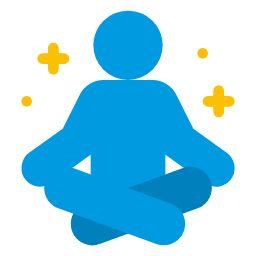“Your goals should be a lighthouse, not a wildfire.”
Let’s be real: goal setting has become a bit… exhausting, hasn’t it? It starts with excitement, ends with overwhelm, and somewhere in between the spark gets lost and everything from life plans to lunch choices starts getting questioned.

But here’s the thing: setting future goals doesn’t have to feel like climbing Mount Everest in flip-flops.
With a little kindness, a sprinkle of strategy, and a lot of heart, it’s possible to set goals that feel less like a pressure cooker and more like a cozy cup of tea on a rainy afternoon.
This isn’t about hustle culture. This is about hopeful culture.
So get cozy, maybe grab something to write with, wrap yourself in your softest blanket, and dig into 7 goal setting steps that support long-term planning and don’t lead to burnout.
🌿 Step 1. Start With the Feeling, Not the To-Do List
Before setting a single goal, pause.
Ask this: “How do you want to feel six months from now?”
Not just what you want to do or achieve, but how you want to feel. Calm? Energized? Fulfilled? Brave? Supported?
Because here’s the plot twist: feelings are the compass. If goals don’t lead to the emotions you’re craving, you’ll end up successful but unsatisfied. And that’s the kind of burnout no bubble bath can fix.
Now, close your eyes for a sec. Imagine waking up in that future space. What’s the vibe? What’s the texture of your day? Are you sipping coffee slowly or rushing out the door? Start from there.
This method of goal setting focuses on emotional alignment and creates motivation that sticks. It’s a foundational part of any self-growth goals approach.
Takeaway: Start with the feeling. The actions will follow.
📌 Step 2. Choose One Focus Area (Yep, Just One)
It’s tempting to want to change everything. Body, bank account, boundaries, breakfast routine…
But trying to change your whole life at once is like trying to carry all your groceries in one trip—something’s gonna snap.
Instead, pick one area of life that matters most right now. Maybe it’s mental health. Maybe it’s finally launching that project that won’t leave you alone. Maybe it’s getting out of survival mode and into soft living.
Think about where you’re most craving relief or excitement. That’s your starting point.
This goal setting strategy keeps you grounded and focused. Prioritizing your personal development helps prevent decision fatigue, boost mental clarity, and avoid emotional overload.
Takeaway: One focus. One intention. One step at a time.
⚡️ Step 3. Shrink the Goal Till It’s Laughably Doable
If a goal makes you sigh just thinking about it, it’s too big.
Shrink it. Shrink it again. Keep going until it feels like, “That’s so easy it’s almost silly.“
Want to start journaling? Don’t commit to a 5-page reflection every night.
Try: “Write one sentence a day.” Boom.
Want to start running? Forget the marathon.
Try: “Put on sneakers and walk for 5 minutes.”
These little moves are sneakily powerful. They’re like planting seeds — small, unassuming, but full of quiet potential.
This approach may support goal setting for mental clarity, especially when dealing with stress, anxiety, or ADHD. It’s how sustainable goals begin.
Takeaway: If it feels hard, make it smaller. Then start.

🌴 Step 4. Flow With Rhythm, Not a Rigid Routine
Let’s be honest—rigid routines can feel like putting your life on a treadmill you didn’t ask for. Instead, think rhythm. Rhythm is flexible, alive, and kind. It meets you where you are.
Rather than locking into a strict schedule like, “I must journal at 7 AM daily,” ask: “When does it feel good to reflect?”
Rhythm is about checking in with your body, your energy, your mood. It’s about noticing the natural beats of your day—when you feel focused, when you need rest, when you crave movement or quiet.
You could swap out task-based thinking for feeling-based guidance. Instead of a to-do list, try a “to-feel” list: grounded, creative, connected. Let that guide what you do next.
This softer structure gives you permission to adapt without guilt. It’s sustainable, kind, and totally human.
Takeaway: Let your life dance to a rhythm that fits you—not a routine that fights you.
You don’t need another schedule that stresses you out. What you need is rhythm.
Rhythm is like a dance. It moves with your energy. It flexes with your mood. It has space for stillness.
So instead of saying, “Do yoga every day at 6am,” try saying, “Stretch whenever your body feels stiff.”
Rhythm honors your cycles. It recognizes that you’re not a robot, you’re a breathing, feeling human being.
This method supports sustainable future goal setting and helps align your energy with your intentions. It’s a critical part of avoiding burnout while achieving success.
Takeaway: Build your future goals around your energy, not against it.
☕️ Step 5. Make Rest Part of the Plan
Here’s something radical: rest is productive.
If goals don’t include time to pause, breathe, play, and stare at the ceiling for no reason—they’re not sustainable.
Rest isn’t what you earn after doing all the things. It’s what allows you to keep doing the things.
Try scheduling one entire day per week to do absolutely nothing goal-related. No guilt. No fixing. No optimizing. Just vibes.
And don’t wait until you “deserve” it. Preventative rest is better than emergency rest.
Rest recalibrates your system. It helps you return to your goals with clearer eyes and a lighter heart.
Adding rest to your goal setting process helps with nervous system regulation and creates space for long-term planning.
Takeaway: Your nervous system deserves a break. Give it one.
🎈 Step 6. Celebrate Tiny Wins Like They’re Huge
Here’s a feel-good secret: want to know what’s even better than hitting a goal?
Answer: Noticing that you’re becoming the kind of person who follows through.
That starts with celebrating the micro wins. Woke up on time? That’s a win. Said “no” when you wanted to people-please? Win. Drank water instead of downing your third coffee? Crown yourself.
Celebration is like emotional confetti for your brain. It tells your nervous system, “Hey, that thing you just did? Do it again!”
You don’t have to wait for the big finish line to cheer. Every little action is a brick in the house you’re building.
Celebrating progress reinforces emotional resilience, sustainable success, and a strong self-growth mindset.
Takeaway: Every small win is a big deal. Treat it like one.

🔀 Step 7. Check In, Don’t Check Out
Here’s the quiet truth about future goals: they evolve.
You will change. Your priorities will shift. That’s not failure—that’s growth.
So instead of abandoning goals the moment things get messy, just check in. Ask:
- Does this still feel like me?
- What’s working?
- What needs a tweak?
Try setting up a regular “goal vibe check.” Light a candle, play music, or just take a moment—whatever helps make it feel intentional.
Treat it like a conversation with your future self. No shame. Just curiosity.
Give permission to pivot, to pause, to re-imagine.
These regular check-ins make the goal setting process adaptable, authentic, and aligned.
Takeaway: Goals aren’t set in stone. They’re set in soft clay. You can reshape them anytime.
🤔 FAQ: Future Goal Setting Without Burnout
Before we wrap things up, let’s take a breather and clear up some of the most common questions that tend to pop up when we’re dreaming about the future without burning ourselves out. Think of this as a cozy conversation where we gently untangle the confusion and find clarity together. ☁️💬
1. What if there are too many goals to choose from?
Start by asking, “Which one would make the biggest emotional impact right now?” Pick one that feels meaningful and manageable. You can always add more later—but focus creates momentum.
2. What if there’s no motivation to even start?
That’s totally valid. Start with mood before move. Instead of waiting to feel motivated, do something tiny that shifts your energy—like stretching, stepping outside, or sipping something warm. Then revisit your goals from that new space.
3. Is it okay to take breaks from goals?
Absolutely. Breaks aren’t backslides—they’re breathing space. Growth isn’t linear, and your rest is part of your progress.
4. How do you tell the difference between burnout and laziness?
Burnout feels like heaviness, fog, and a lack of joy even when you want to care. Laziness is often just misunderstood exhaustion or disconnection. Check in gently. There’s always a reason.
5. Can goals be spiritual or emotional, not just practical?
Yes, yes, and yes. In fact, the best goals often are. Feeling more peaceful, becoming more self-compassionate, reconnecting with joy—those are deeply worthy goals.
6. How often should goals be reviewed?
Try a quick weekly or monthly vibe check. Ask: “Does this still light me up?” No need to overhaul everything. Just stay in relationship with your goals like you would with a friend.
7. What if a goal no longer feels right?
Let it go or reshape it. Goals are tools, not chains. If something no longer serves your growth or peace, you have permission to release it.
💫 Bonus Round: 5 Gentle Tools to Support Your No-Burnout Goals
Because sometimes, a good vibe and a cozy plan need a little backup, right?
Here are five practical (but heart-centered!) tools to keep your goals feeling light, doable, and aligned with the version of you you’re becoming:
- The “One Line a Day” Journal
Instead of pressure to write pages, just jot one sentence each day. It could be how you feel, one thing you’re grateful for, or a win you want to remember. It’s a tiny act with a big ripple.
Why it helps: Builds emotional momentum and reflection without overwhelm.
- A Visual Tracker That Sparks Joy
Use stickers, color codes, or even a hand-drawn chart. Make it fun. Make it you. Seeing your progress grow visually feels so satisfying.
Pro tip: Try tracking “how I felt today” vs. “what I got done.”
- A “Permission Slip” Note
Write yourself a note that says:
“It’s okay to pause. It’s okay to pivot. Growth is still happening.”
Stick it on your mirror, your phone, or your planner.
Because gentle reminders beat guilt trips. Every. Time.
- The 2-Minute Reset Playlist
Create a mini playlist of 2-3 songs that lift your mood, calm your nerves, or make you feel unstoppable. Hit play anytime you feel off-track or out of energy.
Think of it as your sonic sidekick for alignment and recharging.
- A Joy Jar or “Ta-Da” List
Instead of only writing to-dos, start a “ta-da” list or jar. Every time you complete something—big or small—write it down and toss it in. Celebrate it. Look back whenever you need to see how much progress you’ve made and remind yourself of the wins—big or small—that brought you here.
Small wins, seen and savored, build big self-trust.
Takeaway: You don’t need fancy tools. Just ones that feel like a friend.
Pick one. Try it out this week. Keep what works. Ditch what doesn’t. This is your journey—and your toolkit should feel like it fits in your favorite hoodie pocket: warm, simple, and oh-so-you. 💛
🌅 Final Thoughts: You Don’t Need to Be on Fire to Be Lit Up ✨
Let’s leave behind the idea that we have to burn ourselves out just to shine.
Your goals can be gentle. They can be joyful. They can stretch you without stressing you.
And they can still lead to amazing things—not because you forced yourself to the finish line, but because you walked there with care, intention, and a few dance breaks along the way.
So go ahead—set that beautiful future in motion. But do it with softness, not strain.
You’re not behind. You’re not too late. You’re in the right place for this moment in your journey.
And your next step? It doesn’t have to be perfect. It simply needs to belong to you—whatever that looks like, however it feels. 💛
🏡 Bonus: 5 Journal Prompts to Deepen Your Goal-Setting Journey
Journaling can be a gentle way to reconnect with your why—and bring clarity without pressure. Need a little extra support getting started? Here are a few thoughtful prompts to gently guide your reflection:
- What’s one goal you’ve set in the past that drained you—and why?
- When was the last time you felt deeply fulfilled? What were you doing?
- If your future self could give you advice right now, what would they say?
- What would your day look like if it flowed with ease instead of pressure?
- What small joy can you include in your week to support your goals?
Take your time with these. There’s no rush. Just explore.
Because when goals are rooted in who you are (and how you want to feel), they grow in the most beautiful ways. 🌱

🌿 Your Turn: Let This Be the Day You Start
By now, you’ve gathered the tools, the clarity, and hopefully a little bit of inspiration to set goals that fuel your spirit instead of draining it. But reading isn’t the same as doing—so here’s your gentle nudge to take action, even if it’s a tiny one.
- Take five minutes right now.
- Jot down one way you want to feel.
- Pick one focus area for your future.
- Then take the tiniest step you can think of.
That’s the beginning of your sustainable goal setting journey.
This tiny step you’re taking today? Your future self is already sending you a warm, grateful smile for starting today.
Now you’re not just setting goals. You’re setting yourself up for growth with grace.
And that, dear reader, is the kind of future that feels like home. 🌛
 Heal City Health, Fitness and Lifestyle Online Magazine
Heal City Health, Fitness and Lifestyle Online Magazine




